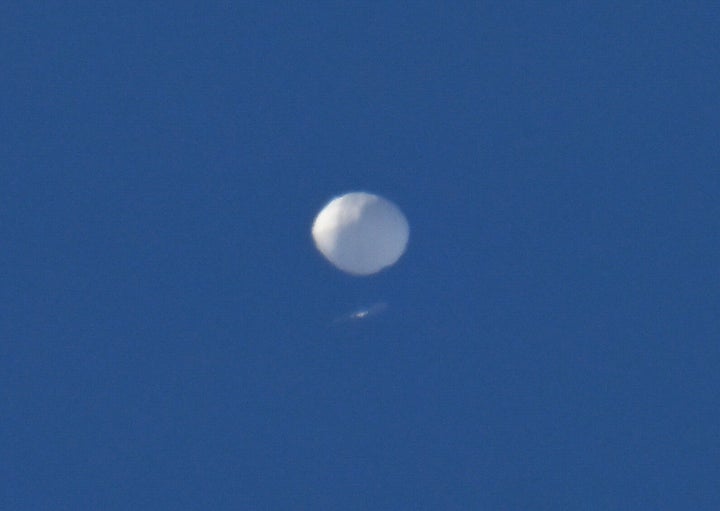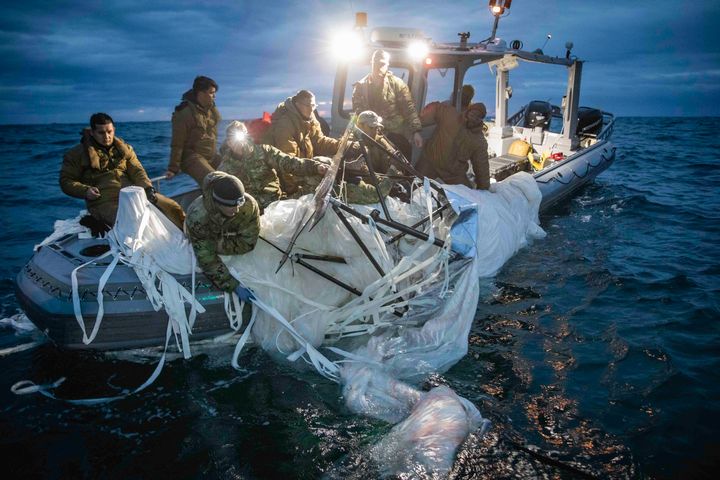Officials in the US (and the UK) are becoming increasingly worried about the flurry of unidentified flying objects spotted in airspace over North America.
Sightings of these UFOs, as they are more commonly known, have suddenly started ramping up over the last fortnight.
How did the ‘balloon’ drama start?
It began on February 4, when the US saw a large white object hanging over Montana. It soon shot the suspected Chinese spy balloon down when the falling debris would not affect any civilians below.
This led US secretary of state Antony Blinken to cancel a planned trip to Beijing, claiming China’s supposed attempt at spying was “unacceptable and irresponsible”.
China eventually claimed this first object was a weather balloon which blew off course.
Then, another UFO popped up, this time over Alaska, with a third appearing over northern Canada on February 11.
The US shot down a fourth unmanned “octagonal structure” in Michigan near the Canadian border on Sunday, February 12.
US authorities have also revealed that several other balloons had floated across the country in recent years, without being spotted. At least three entered US airspace during Donald Trump’s administration and one early on during Joe Biden’s time in the White Office, according to US defence officials.
Why are there more sightings of the flying objects now than before?
US military commander General Glen VanHerck explained last week that a “domain awareness gap” had stopped authorities from picking up the balloons previously.
“It’s my responsibility to detect threats to North America. I will tell you that we did not detect those threats,” General VanHerck said.
The New York Times and Bloomberg suggested that they may have been classed as UFOs at the time.
So what’s changed?
Extra intelligence means the US has now classed them as surveillance balloons.
As White House national security adviser Jake Sullivan explained: “We enhanced our capacity to be able to detect things that the Trump administration was unable to detect.”
Reports suggest that the US has now changed how it receives and interprets information coming from radars and sensors around the American airspace.
Sensors usually absorb a lot of raw data which are then put through filters. That means it doesn’t present the humans reading it with all of the data, just the bits it is able to classify into one thing or another.
As one official told the Washington Post: “We basically opened the filters.”
The Washington Post explained that this was “much like a car buyer unchecking boxes on a website to broaden the parameters of what can be searched”.
Even so, the official cautioned that this change in tactic does not yet fully answer what is going on.
They said it was unclear whether stepping back to look at more data was responsible for the growing number of occurrences or if the latest incursions are part of more deliberate attempt from an unidentified country.
To make matters more complicated, each object is “slightly different in profile”, according to the anonymous official, making it harder for the sensors to detect them.

Do we know what the balloons are?
It’s not clear yet – as China continues to deny that they were used for surveillance – but experts are currently recovering and analysing the wreckage of the shot down objects.
It’s not clear what information they are collecting.
But, General VanHerck said there was no indication of any threat from the latest object – although he said he could not rule out that the objects were extra-terrestrials.
Weather conditions are also slowing down the efforts to reach, recover and analyse the objects as they scattered across large areas of land, particularly the one shot down over Alaska.

How has China reacted?
China’s foreign ministry spokesman Wang Wenbin said that he had “no understanding” of any of these objects.
But, he added that the US’s “frequent firing of advanced missile used to strike down the unidentified flying objects is an overreaction of excessive force”.
Then, Wang alleged that the US has “illegally” flown its own balloons into the “airspace of other countries”, supposedly flying above China more than 10 times since last year alone – without approval of Chinese authorities.
He said: ”“The first thing the US side should do is start with a clean slate, undergo some self-reflection, instead of smearing and accusing China.”
Washington has not yet responded.
How has the West responded?
The UK is now looking to organise a security review into how it monitors its own air space.
Prime minister Rishi Sunak said Downing Street will do “whatever it takes” to keep the country safe from the threat of spy balloons.
“We have something called the quick reaction alert force which involves Typhoon planes, which are kept on 24/7 readiness to police our airspace, which is incredibly important,” he said.
President Joe Biden is now working with intelligence agencies to increase attempts to identify spying operations.

